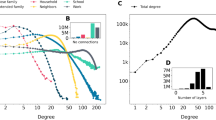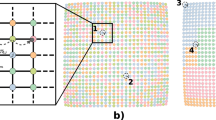Abstract
Diffusion processes are central to human interactions. One common prediction of the current modelling frameworks is that initial spreading dynamics follow exponential growth. Here we find that, for subjects ranging from mobile handsets to automobiles and from smartphone apps to scientific fields, early growth patterns follow a power law with non-integer exponents. We test the hypothesis that mechanisms specific to substitution dynamics may play a role, by analysing unique data tracing 3.6 million individuals substituting different mobile handsets. We uncover three generic ingredients governing substitutions, allowing us to develop a minimal substitution model, which not only explains the power-law growth, but also collapses diverse growth trajectories of individual constituents into a single curve. These results offer a mechanistic understanding of power-law early growth patterns emerging from various domains and demonstrate that substitution dynamics are governed by robust self-organizing principles that go beyond the particulars of individual systems.
This is a preview of subscription content, access via your institution
Access options
Access Nature and 54 other Nature Portfolio journals
Get Nature+, our best-value online-access subscription
$29.99 / 30 days
cancel any time
Subscribe to this journal
Receive 12 digital issues and online access to articles
$119.00 per year
only $9.92 per issue
Buy this article
- Purchase on Springer Link
- Instant access to full article PDF
Prices may be subject to local taxes which are calculated during checkout




Similar content being viewed by others
Data availability
Data necessary to reproduce the results in the manuscript are available. The datasets for automobiles, smartphone apps and scientific fields are publicly available at https://chingjin.github.io/substitution/. The mobile phone dataset is not publicly available due to commercially sensitive information contained, but is available from the corresponding author on reasonable request.
Code availability
The custom code used is available at https://chingjin.github.io/substitution/.
References
Barrat, A., Barthelemy, M. & Vespignani, A. Dynamical Processes on Complex Networks (Cambridge Univ. Press, 2008).
Ben-Avraham, D. & Havlin, S. Diffusion and Reactions in Fractals and Disordered Systems (Cambridge Univ. Press, 2000).
Pastor-Satorras, R., Castellano, C., Van Mieghem, P. & Vespignani, A. Epidemic processes in complex networks. Rev. Mod. Phys. 87, 925 (2015).
Rogers, E. M. Diffusion of Innovations (Simon and Schuster, 1962).
Gladwell, M. The Tipping Point: How Little Things Can Make a Big Difference (Little Brown, 2006).
Anderson, R. M., May, R. M. & Anderson, B. Infectious Diseases of Humans: Dynamics and Control Vol. 28 (Wiley, 1992).
Colizza, V., Barrat, A., Barthélemy, M. & Vespignani, A. The role of the airline transportation network in the prediction and predictability of global epidemics. Proc. Natl Acad. Sci. USA 103, 2015–2020 (2006).
Brockmann, D. & Helbing, D. The hidden geometry of complex, network-driven contagion phenomena. Science 342, 1337–1342 (2013).
Bass, F. M. A new product growth for model consumer durables. Manag. Sci. 15, 215–227 (1969).
Fisher, J. C. & Pry, R. H. A simple substitution model of technological change. Technol. Forecast. Soc. Change 3, 75–88 (1972).
Banerjee, A., Chandrasekhar, A. G., Duflo, E. & Jackson, M. O. The diffusion of microfinance. Science 341, 1236498 (2013).
Karsai, M., Iñiguez, G., Kaski, K. & Kertész, J. Complex contagion process in spreading of online innovation. J. R. Soc. Interface 11, 20140694 (2014).
Aral, S., Muchnik, L. & Sundararajan, A. Distinguishing influence-based contagion from homophily-driven diffusion in dynamic networks. Proc. Natl Acad. Sci. USA 106, 21544–21549 (2009).
Weiss, C. H. et al. Adoption of a high-impact innovation in a homogeneous population. Phys. Rev. X 4, 041008 (2014).
Merton, R. K. The Sociology of Science: Theoretical and Empirical Investigations (Univ. Chicago Press, 1973).
Evans, J. & Foster, J. Metaknowledge. Science 331, 721–725 (2011).
Granovetter, M. S. The strength of weak ties. Am. J. Sociol. 78, 1360–1380 (1973).
Onnela, J.-P. et al. Structure and tie strengths in mobile communication networks. Proc. Natl Acad. Sci. USA 104, 7332–7336 (2007).
Pentland, A. Social Physics: How Social Networks Can Make Us Smarter (Penguin, 2015).
Christakis, N. A. & Fowler, J. H. The spread of obesity in a large social network over 32 years. N. Engl. J. Med. 357, 370–379 (2007).
Centola, D. The spread of behavior in an online social network experiment. Science 329, 1194–1197 (2010).
Morone, F. & Makse, H. A. Influence maximization in complex networks through optimal percolation. Nature 524, 65–68 (2015).
Castellano, C., Fortunato, S. & Loreto, V. Statistical physics of social dynamics. Rev. Mod. Phys. 81, 591 (2009).
Kuhn, T. The Structure of Scientific Revolutions (Univ. Chicago Press, 1996).
Jia, T., Wang, D. & Szymanski, B. K. Quantifying patterns of research-interest evolution. Nat. Hum. Behav. 1, 0078 (2017).
Barabási, A.-L. Network Science (Cambridge Univ. Press, 2016).
Zang, C., Cui, P. & Faloutsos, C. Beyond sigmoids: the nettide model for social network growth, and its applications. In Proc. 22nd ACM SIGKDD International Conference on Knowledge Discovery and Data Mining 2015–2024 (ACM, 2016).
Song, C., Qu, Z., Blumm, N. & Barabási, A.-L. Limits of predictability in human mobility. Science 327, 1018–1021 (2010).
Kooti, F. et al. Portrait of an online shopper: understanding and predicting consumer behavior. In Proc. Ninth ACM International Conference on Web Search and Data Mining 205–214 (ACM, 2016).
Chowell, G., Viboud, C., Hyman, J. M. & Simonsen, L. The western Africa Ebola virus disease epidemic exhibits both global exponential and local polynomial growth rates. PLoS Curr. https://doi.org/10.1371/currents.outbreaks.8b55f4bad99ac5c5db3663e916803261 (2015).
Chowell, G., Sattenspiel, L., Bansal, S. & Viboud, C. Mathematical models to characterize early epidemic growth: a review. Phys. Life Rev. 18, 66–97 (2016).
Chowell, G., Viboud, C., Simonsen, L., Merler, S. & Vespignani, A. Perspectives on model forecasts of the 2014–2015 Ebola epidemic in West Africa: lessons and the way forward. BMC Med. 15, 42 (2017).
Danon, L. & Brooks-Pollock, E. The need for data science in epidemic modelling: comment on: “Mathematical models to characterize early epidemic growth: a review” by Gerardo Chowell et al. Phys. Life Rev. 18, 102–104 (2016).
Chowell, G., Sattenspiel, L., Bansal, S. & Viboud, C. Early sub-exponential epidemic growth: simple models, nonlinear incidence rates, and additional mechanisms: reply to comments on “Mathematical models to characterize early epidemic growth: a review.” Phys. Life Rev. 18, 114–117 (2016).
Wu, F. & Huberman, B. A. Novelty and collective attention. Proc. Natl Acad. Sci. USA 104, 17599–17601 (2007).
Crane, R. & Sornette, D. Robust dynamic classes revealed by measuring the response function of a social system. Proc. Natl Acad. Sci. USA 105, 15649–15653 (2008).
Iribarren, J. L. & Moro, E. Impact of human activity patterns on the dynamics of information diffusion. Phys. Rev. Lett. 103, 038702 (2009).
Gleeson, J. P., O’Sullivan, K. P., Baños, R. A. & Moreno, Y. Effects of network structure, competition and memory time on social spreading phenomena. Phys. Rev. X 6, 021019 (2016).
Gleeson, J. P., Cellai, D., Onnela, J.-P., Porter, M. A. & Reed-Tsochas, F. A simple generative model of collective online behavior. Proc. Natl Acad. Sci. USA 111, 10411–10415 (2014).
Shen, H. -W., Wang, D., Song, C. & Barabási, A. -L. Modeling and predicting popularity dynamics via reinforced Poisson processes. In Proc. 28th AAAI Conference on Artificial Intelligence 14, 291–297 (2014).
Wang, D., Song, C. & Barabási, A.-L. Quantifying long-term scientific impact. Science 342, 127–132 (2013).
Serrano, M. Á., Boguná, M. & Vespignani, A. Extracting the multiscale backbone of complex weighted networks. Proc. Natl Acad. Sci. USA 106, 6483–6488 (2009).
Lotka, A. J. Contribution to the theory of periodic reactions. J. Phys. Chem. 14, 271–274 (1910).
Volterra, V. Variations and fluctuations of the number of individuals in animal species living together. J. Cons. Int. Explor. Mer. 3, 3–51 (1928).
Salganik, M. J., Dodds, P. S. & Watts, D. J. Experimental study of inequality and unpredictability in an artificial cultural market. Science 311, 854–856 (2006).
van de Rijt, A., Kang, S. M., Restivo, M. & Patil, A. Field experiments of success-breeds-success dynamics. Proc. Natl Acad. Sci. USA 111, 6934–6939 (2014).
Watts, D. J. Everything is Obvious:* Once You Know the Answer (Crown Business, 2011).
Eagle, N., Pentland, A. S. & Lazer, D. Inferring friendship network structure by using mobile phone data. Proc. Natl Acad. Sci. USA 106, 15274–15278 (2009).
Valera, I. & Gomez-Rodriguez, M. Modeling adoption and usage of competing products. In 2015 IEEE International Conference on Data Mining (ICDM) 409–418 (IEEE, 2015).
Dasgupta, K. et al. Social ties and their relevance to churn in mobile telecom networks. In Proc. 11th International Conference on Extending Database Technology: Advances in Database Technology 668–677 (ACM, 2008).
Sundsøy, P. R., Bjelland, J., Canright, G., Engø-Monsen, K. & Ling, R. Product adoption networks and their growth in a large mobile phone network. In 2010 International Conference on Advances in Social Networks Analysis and Mining 208–216 (IEEE, 2010).
Deville, P. et al. Scaling identity connects human mobility and social interactions. Proc. Natl Acad. Sci. USA 113, 7047–7052 (2016).
Hèbert-Dufresne, L. & Althouse, B. M. Complex dynamics of synergistic coinfections on realistically clustered networks. Proc. Natl Acad. Sci. USA 112, 10551–10556 (2015).
Scarpino, S. V. et al. Epidemiological and viral genomic sequence analysis of the 2014 Ebola outbreak reveals clustered transmission. Clin. Infect. Dis. 60, 1079–1082 (2014).
Scarpino, S. V., Allard, A. & Hèbert-Dufresne, L. The effect of a prudent adaptive behaviour on disease transmission. Nat. Phys. 12, 1042–1046 (2016).
Viboud, C., Simonsen, L. & Chowell, G. A generalized-growth model to characterize the early ascending phase of infectious disease outbreaks. Epidemics 15, 27–37 (2016).
Acknowledgements
We thank B. Uzzi, J. Colyvas, J. Chu, M. Kouchaki, Q. Zhang, Z. Ma and all members of the Northwestern Institute on Complex Systems (NICO) for helpful comments. We are indebted to A.-L. Barabási for initial collaboration on this project and invaluable feedback on the manuscript. This work was supported by the Air Force Office of Scientific Research under award number FA9550-15-1-0162 and FA9550-17-1-0089, Northwestern University’s Data Science Initiative, and National Science Foundation grant SBE 1829344. C.S. was supported by the National Science Foundation (IBSS-L-1620294) and by a Convergence Grant from the College of Arts & Sciences, University of Miami. The funders had no role in study design, data collection and analysis, decision to publish or preparation of the manuscript.
Author information
Authors and Affiliations
Contributions
All authors designed the research. C.J., C.S. and D.W. conducted the analytical and numerical calculations. C.J., C.S., J.B. and D.W. analysed the empirical data. D.W. was the lead writer of the manuscript.
Corresponding author
Ethics declarations
Competing interests
The authors declare no competing interests.
Additional information
Peer review information: Primary Handling Editor: Stavroula Kousta.
Publisher’s note: Springer Nature remains neutral with regard to jurisdictional claims in published maps and institutional affiliations.
Supplementary information
Supplementary Information
Supplementary Notes 1–4, Supplementary Figs. 1–30, Supplementary Tables 1–3, and Supplementary References.
Rights and permissions
About this article
Cite this article
Jin, C., Song, C., Bjelland, J. et al. Emergence of scaling in complex substitutive systems. Nat Hum Behav 3, 837–846 (2019). https://doi.org/10.1038/s41562-019-0638-y
Received:
Accepted:
Published:
Issue Date:
DOI: https://doi.org/10.1038/s41562-019-0638-y
This article is cited by
-
Data, measurement and empirical methods in the science of science
Nature Human Behaviour (2023)
-
Scientific prizes and the extraordinary growth of scientific topics
Nature Communications (2021)



